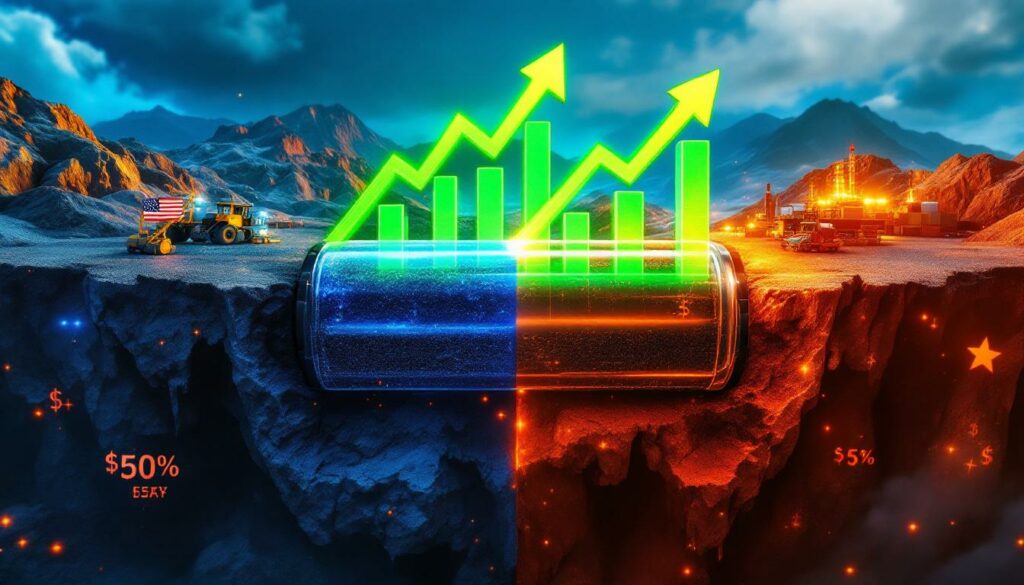Why Are U.S. Graphite Producers Gaining Attention Amid New China Tariffs?
The U.S. graphite industry is experiencing unprecedented momentum as new tariffs dramatically reshape the battery material supply chain. With Chinese imports now facing duties that effectively price them out of the market, domestic producers are positioned for what analysts describe as a "once-in-a-generation growth opportunity." The strategic significance of graphite—essential for EV batteries, energy storage, and defense applications—has transformed what was once an overlooked mineral into a centerpiece of economic security discussions.
According to the International Energy Agency, the U.S. graphite supply chain remains "highly vulnerable to disruptions," with China currently supplying over 90% of global anode-grade graphite. This dependency has become increasingly problematic as geopolitical tensions rise and clean energy transitions accelerate.
What Are the New Tariffs on Chinese Graphite Imports?
Understanding the Scale of the New Duties
The U.S. Commerce Department has imposed substantial preliminary anti-dumping tariffs of 93.5% on anode-grade graphite imported from China. When combined with existing countervailing duties of approximately 66.5%, this brings the total duty rate to approximately 160% for most Chinese producers. The decision targets nearly $350 million worth of graphite imports annually, based on allegations that Chinese manufacturers are selling their products below fair market value in the U.S. market.
The magnitude of these tariffs impact on markets represents one of the most aggressive trade actions taken against Chinese industrial materials in recent years, reflecting growing concerns about supply chain security for critical minerals.
Extreme Penalties for Specific Companies
For certain Chinese manufacturers, the tariffs are even more severe. Huzhou Kaijin New Energy Technology and Shanghai Shaosheng Knitted Sweat face punitive duties exceeding 700%, effectively shutting them out of the U.S. market entirely. These unprecedented rates signal the Commerce Department's aggressive stance on what it considers unfair trade practices and potential national security concerns.
"These duties are designed not just to level the playing field but to completely redraw the map of global graphite supply chains," noted Sam Adham, Head of Battery Materials at CRU Group.
Timeline for Implementation
The preliminary tariffs were announced in July 2025, with final determinations expected by December 5, 2025. This timeline gives battery manufacturers and graphite producers several months to adjust their supply chains and business strategies before the final rates are locked in.
The phased implementation reflects recognition of the complex supply chain adjustments needed, though many industry observers believe the final determination is unlikely to significantly reduce the tariff levels.
How Did the Graphite Tariff Dispute Begin?
The Petition That Started It All
The tariff investigation began following a December 2024 petition filed by the American Active Anode Material Producers coalition, which includes companies like Northern Graphite Corporation. This group alleged that Chinese graphite producers were engaging in anti-competitive practices by dumping artificially low-priced graphite into the U.S. market, harming domestic producers' ability to compete.
The petition documented specific instances where Chinese graphite was priced 30-45% below production costs, making it impossible for U.S. producers to establish economically viable operations despite growing demand from the battery sector.
China's Retaliatory Export Restrictions
The dispute escalated when China implemented export restrictions on several critical minerals in December 2024, including gallium, germanium, antimony, and graphite. These restrictions took the form of new licensing requirements and quota systems that significantly limited export volumes.
These restrictions were widely viewed as a response to increasing U.S. trade pressures and have created additional complications for global supply chains, particularly for industries dependent on semiconductors, electronics, and renewable energy technologies.
A less-discussed aspect of China's dominance in graphite is the environmental cost. Processing graphite involves significant use of hydrofluoric acid and other chemicals that can cause serious environmental damage when not properly managed—a factor that has historically kept production concentrated in regions with less stringent environmental regulations.
What Impact Will These Tariffs Have on Battery Production?
Rising Battery Costs
According to Sam Adham, Head of Battery Materials at CRU Group, the tariffs could increase battery costs by approximately $7 per kilowatt-hour (kWh). For context, industry analysts estimate current battery pack costs at around $120-150/kWh, meaning the tariffs could add 4.5-6% to overall battery costs.
This represents a significant cost increase that could effectively eliminate about 20% of the tax credits available under the U.S. Inflation Reduction Act (IRA). For a typical 75kWh EV battery pack, this translates to approximately $525 in additional costs per vehicle.
Changing Sourcing Strategies
Michael O'Kronley, CEO of Novonix, has indicated that the tariffs will fundamentally alter battery manufacturers' sourcing strategies in the United States. "I think this is going to change behaviors and sourcing strategies of battery manufacturers in the United States," O'Kronley stated, adding that the ruling would accelerate discussions between his company and manufacturers.
With Chinese graphite imports becoming substantially more expensive, manufacturers will need to accelerate discussions with alternative suppliers and potentially invest in domestic production capacity, though this transition will not happen overnight.
Opposition from Major EV Players
Major electric vehicle manufacturers and battery producers, including Tesla and Panasonic, have lobbied against the tariffs. They argue that the domestic supply chain is currently insufficient to meet their quality and volume requirements, potentially creating bottlenecks in production and increasing costs for consumers.
Industry insiders note that synthetic graphite, which accounts for approximately 70% of battery anode material, requires specialized production facilities with carbon precursors derived from petroleum refining—capabilities that are limited outside China. Natural graphite requires extensive purification and processing to reach battery-grade specifications, with current U.S. capacity meeting less than 10% of demand.
How Are Markets Responding to the Tariff News?
Stock Market Reactions
The market response to the tariff announcement has been dramatic and immediate:
- Tesla shares fell approximately 3% as investors anticipated higher battery production costs
- Non-Chinese graphite producers saw substantial gains:
- Northern Graphite Corporation (Canada) doubled in value
- Syrah Resources Ltd. (Australia) surged nearly 40%
- Novonix Ltd. (Australia/U.S.) jumped 21%
- Nouveau Monde Graphite (Canada) gained 23%
- POSCO Holdings Inc. (South Korea) increased by 5%
Trading volumes for these stocks were 5-10 times higher than their daily averages, indicating strong investor interest in repositioning portfolios to capitalize on the shifting graphite landscape.
Wall Street's Bullish Outlook
Investment analysts are increasingly optimistic about the U.S. graphite sector's prospects. They predict that major battery manufacturers like Tesla will be compelled to shift their sourcing to domestic producers, creating significant growth opportunities for North American and allied graphite companies.
Eugene Hsiao, head of China equity strategy at Macquarie Capital, noted: "The U.S. is likely to be promoting the development of its own graphite industry by forcing domestic battery makers to switch suppliers."
Morgan Stanley analysts have predicted that the graphite sector could see over $1.2 billion in new investment over the next 24 months as companies race to develop domestic production capacity, potentially creating a "gold rush" scenario for early movers in the space.
What Is the Current State of U.S. Graphite Supply?
Heavy Reliance on Chinese Imports
The United States imported approximately 180,000 metric tons of graphite in 2023, with two-thirds of this volume coming from China. This heavy dependence on Chinese imports has created significant supply chain vulnerabilities that the International Energy Agency (IEA) has identified as requiring urgent diversification efforts.
Natural graphite is found in metamorphic rocks formed by the transformation of organic carbon under heat and pressure. While the U.S. has substantial graphite resources—particularly in Alaska, Montana, and Alabama—commercial production ceased in the 1990s when Chinese suppliers entered the market with significantly lower prices.
Domestic Production Capacity
Currently, the U.S. has limited domestic graphite production capacity. Companies like Novonix operate processing facilities, such as their plant in Chattanooga, Tennessee, but the country lacks sufficient mining and processing infrastructure to meet current demand without imports.
A critical distinction in graphite production is between natural graphite (mined from deposits) and synthetic graphite (manufactured from petroleum coke). While natural graphite is less expensive, synthetic graphite often delivers superior performance in battery applications due to its higher purity and consistent properties. U.S. companies generally focus on high-value synthetic graphite due to the economics of domestic production.
Strategic Importance of Graphite
According to the IEA, graphite will remain the most widely used anode material in lithium-ion batteries for at least the next five years. While silicon is expected to gradually gain market share after 2030, graphite's dominance in battery technology makes it a strategically critical material for energy transition and national security.
The U.S. Geological Survey classifies graphite as one of 35 critical energy minerals deemed critical to economic and national security. Unlike lithium and cobalt, which have received significant attention, graphite has remained relatively overlooked despite typically constituting 25-30% of a lithium-ion battery's weight.
How Will These Tariffs Affect the EV Industry?
Potential Production Declines
Analysis from the International Council on Clean Transportation projected that U.S. battery production could decline by approximately 75% by 2030 to 250 GWh under current policies. Electric vehicle sales could potentially drop by 40% during the same period compared to projections made under previous policy frameworks.
This stark forecast assumes that manufacturers would be unable to quickly develop alternative supply chains or pass increased costs to consumers. Some industry experts consider these projections overly pessimistic, pointing to the adaptability of global supply chains and the potential for accelerated domestic development.
Job Creation Concerns
The same report suggests that current policies could eliminate approximately 130,000 potential jobs in the EV sector by 2030, with the majority of these losses occurring in battery manufacturing. This represents a significant shift from previous projections that were based on incentives provided by the 2022 Inflation Reduction Act.
However, advocates of the tariffs argue that they could create new jobs in the domestic graphite industry. The American Active Anode Material Producers coalition estimates that a robust domestic graphite industry could create 15,000-25,000 direct jobs across mining, processing, and manufacturing.
Battery Manufacturing Investments
Prior to recent policy changes, companies had announced plans for 128 U.S. battery manufacturing facilities, spurred by generous credits under the IRA. More than half of these facilities have yet to begin construction, and their future may now be uncertain given the changing economic landscape.
Industry analysts note that companies with flexible supply chain strategies and the ability to source from multiple regions will be best positioned to navigate the new tariff environment. This could accelerate a trend toward regional battery production hubs that incorporate local mineral processing.
Which Companies Stand to Benefit from the Tariffs?
North American Graphite Producers
Several North American companies are positioned to benefit significantly from the tariffs:
-
Northern Graphite Corporation (Canada) – One of the companies that lobbied for the tariffs on Chinese graphite, with operations in Canada and Namibia. Their Bissett Creek project in Ontario is expected to produce 20,000-25,000 tons of concentrate annually when operational.
-
Nouveau Monde Graphite (Canada) – Developing a fully integrated mine-to-market graphite operation in Quebec with planned annual production of 100,000 tons of anode material. The company uses hydroelectric power for processing, allowing them to market their product as environmentally sustainable.
-
Novonix (Australia/U.S.) – Operating a processing facility in Tennessee focused on synthetic graphite production with capacity for 10,000 tons annually, expanding to 40,000 tons by 2026. Their proprietary technology claims to reduce energy use in synthetic graphite production by up to 30%.
Australian and Other Allied Nation Producers
Companies from allied nations with existing graphite production are also likely beneficiaries:
-
Syrah Resources (Australia) – Operating the Balama graphite mine in Mozambique, which has a theoretical capacity of 350,000 tons annually, and developing processing capacity in Louisiana with initial production of 11,250 tons of active anode material.
-
POSCO Holdings (South Korea) – A major industrial conglomerate with significant investments in battery metals investment, including a joint venture with Syrah Resources to develop natural graphite processing facilities.
These companies not only stand to capture market share but may also see increased valuations as strategic investors and battery manufacturers seek to secure supply chain stakes through equity investments or off-take agreements.
What Are the Broader Geopolitical Implications?
Escalating U.S.-China Trade Tensions
The graphite tariffs represent a significant escalation in trade tensions between the United States and China, particularly in the critical minerals and clean energy sectors. This follows a pattern of increasing restrictions and counter-restrictions that have characterized the US-China trade war in recent years.
Energy security experts note that the tariffs reflect a broader strategic shift from economic efficiency to supply chain resilience and national security considerations. This paradigm shift is occurring across multiple industries but is particularly pronounced in sectors deemed critical to energy transition and defense capabilities.
Supply Chain Restructuring
The tariffs are likely to accelerate the restructuring of global battery supply chains, with increased emphasis on "friend-shoring" critical minerals production to allied nations. This could lead to new investments in graphite production in countries like Australia, Canada, and various African nations with graphite resources.
Mozambique, Madagascar, and Tanzania have particularly significant natural graphite reserves that remain underdeveloped. With appropriate investment and technology transfer, these countries could become important alternative suppliers, though challenges related to infrastructure, political stability, and environmental regulations remain.
Impact on Chinese Producers
Chinese graphite producers who have long dominated both synthetic and natural graphite anode markets with low-cost exports will face significant challenges. With effective tariff rates reaching 160% (and over 700% for certain producers), their cost advantage in the U.S. market has effectively disappeared overnight.
This could potentially lead to overcapacity in the Chinese market and downward price pressure in non-U.S. markets as producers seek to redirect export volumes. Smaller Chinese producers with limited technological differentiation are particularly vulnerable, while larger integrated battery material companies may have more flexibility to adapt.
What Are the Long-Term Prospects for U.S. Graphite Production?
Investment Opportunities
The tariffs create substantial mining investment opportunities for domestic graphite production, potentially attracting capital to both mining and processing operations. Companies with existing projects or plans for U.S.-based production are likely to see increased interest from investors and potential customers.
Industry experts suggest that the most economically viable approach for U.S. production may be a hybrid model that combines domestic synthetic graphite manufacturing with natural graphite purification and processing facilities using imported concentrates from allied nations.
Technology Development
The need for domestic graphite production could accelerate research and development in more efficient and environmentally friendly graphite processing technologies. This could include advances in synthetic graphite production and natural graphite purification methods.
Of particular interest are technologies that reduce or eliminate the use of hydrofluoric acid in graphite processing, as well as processes that minimize energy consumption. Several U.S. universities and national laboratories are researching alternative purification methods using mechanical, thermal, or biological processes that could reduce environmental impacts.
Integration with Broader Battery Supply Chain
Successful development of a domestic graphite industry would need to integrate with broader efforts to establish a complete battery supply chain in North America. This includes coordination with lithium, nickel, cobalt, and manganese production, as well as cathode and cell manufacturing.
The U.S. Department of Energy's Federal Consortium for Advanced Batteries (FCAB) has outlined a strategic plan that identifies graphite as a key component of domestic battery production. Their roadmap calls for the U.S. to develop capacity to supply 100% of domestic battery-grade graphite demand by 2030—a target that now appears more achievable with the tariff protection.
FAQs About U.S. Graphite and the New Tariffs
What is anode-grade graphite and why is it important?
Anode-grade graphite is a highly processed form of graphite used to create the negative electrode (anode) in lithium-ion batteries. It must meet strict specifications for purity (typically 99.95% carbon or higher), particle size, and performance characteristics. This material is critical for battery production as it determines battery capacity, charging speed, and overall lifespan.
The anode functions by storing lithium ions during charging and releasing them during discharge. While other materials like silicon and lithium metal show promise as anode materials, graphite remains dominant due to its stability, abundance, and established manufacturing processes.
How will these tariffs affect electric vehicle prices?
The tariffs could increase battery costs by approximately $7/kWh, which would translate to roughly $420-$700 in additional costs for a typical EV battery pack (60-100 kWh). However, the actual impact on vehicle prices will depend on how quickly domestic and non-Chinese supply can ramp up, and whether manufacturers absorb some of these costs or pass them on to consumers.
For context, a $500 increase represents approximately 1
Want to Identify the Next Major Mineral Discovery?
Discover why graphite is just one of many critical minerals creating investment opportunities by exploring Discovery Alert's proprietary Discovery IQ model, which delivers real-time alerts on significant ASX mineral discoveries. Visit the Discovery Alert discoveries page to understand how major mineral discoveries can lead to exceptional market returns and position yourself ahead of the market.




